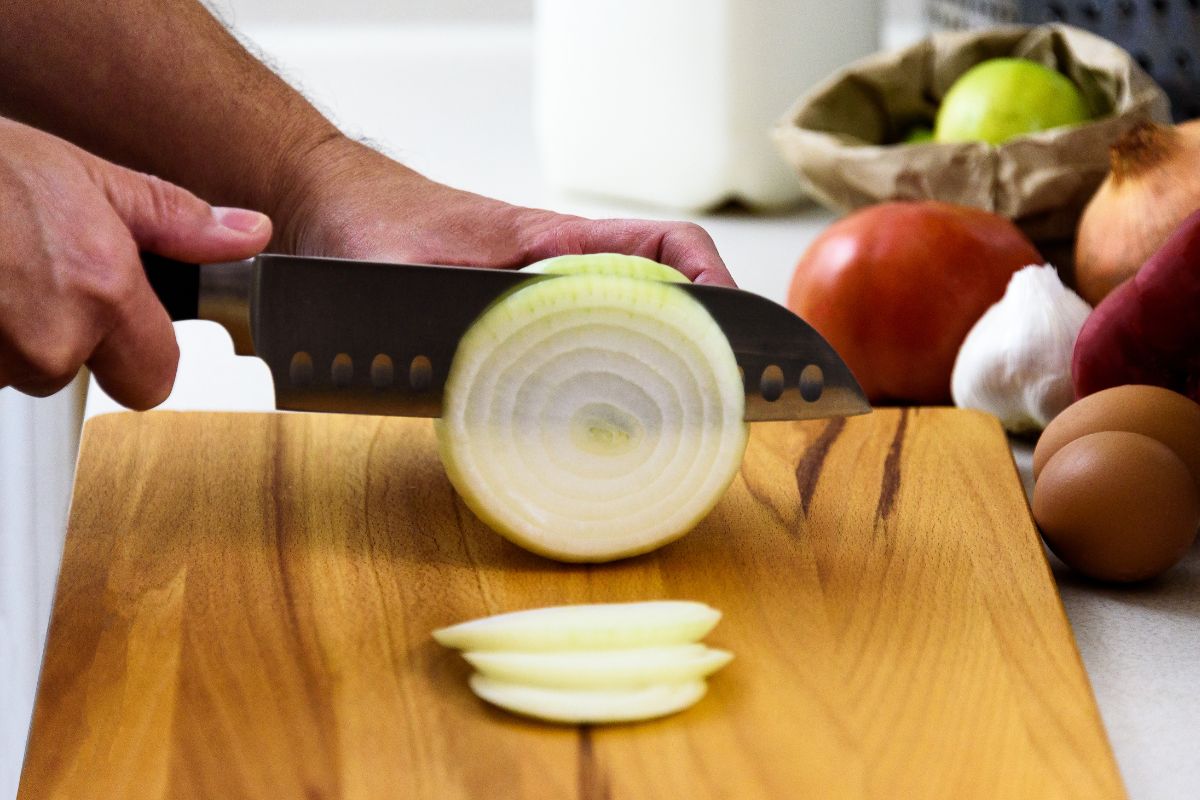Chopping onions is a fundamental cooking skill that many home chefs dread due to the inevitable tears that follow. Recent scientific research from Cornell University has finally provided a definitive answer to this culinary conundrum. Their findings reveal that the key to tear-free onion cutting lies in two simple factors: using a sharp knife and cutting slowly. This breakthrough could transform how we approach this essential kitchen task and make meal preparation more enjoyable for everyone.
The science behind onion tears
When you slice into an onion, you’re breaking open cells that contain enzymes and sulfur compounds. These components mix together and create syn-propanethial-S-oxide, a volatile gas that rises through the air and irritates the sensitive membranes in your eyes. Your eyes respond to this irritation by producing tears to wash away the irritant.
Scientists at Cornell University conducted detailed experiments to understand exactly how this irritating compound gets released during cutting. Using a specially designed guillotine fitted with different blades, they meticulously documented the spray patterns produced when cutting onions under various conditions.
The research team captured high-speed footage of onion juice ejection during cutting, allowing them to analyze precisely how much spray was produced and what factors influenced it. This methodical approach finally provided scientific validation for what many chefs have long suspected about knife sharpness.
The relationship between our dietary choices and bodily functions extends beyond cooking techniques. Research has shown that the brain can change intestinal bacteria in a couple of hours, highlighting how interconnected our body systems truly are.
Sharp knives create fewer tears
The Cornell study conclusively demonstrated that knife sharpness plays a crucial role in determining how much onion spray is produced during cutting. Dull blades significantly increase both the speed and number of ejected droplets that carry the tear-inducing compound.
When using a blunt knife, the researchers observed that the blade tends to push down on the onion’s layers before actually cutting through them. This compression forces the layers to bend inward, storing elastic energy. As the cut progresses, these compressed layers spring back, forcefully ejecting juice into the air – and ultimately into your eyes.
In contrast, sharp blades slice cleanly through the onion’s cellular structure with minimal compression. This precision cutting reduces the amount of juice that gets sprayed into the surrounding air, resulting in fewer tears for the person doing the chopping.
Maintaining a healthy lifestyle includes not just proper cooking techniques but also regular exercise. Studies show that taking 7,000 steps daily can significantly improve health, making it an achievable goal for most people.
Cutting speed matters
The second critical factor identified by the Cornell researchers was cutting speed. Contrary to what many might assume, faster cutting actually produces more tears, not fewer. The research team found that rapid cutting motions generated more juice and created a finer mist of the irritating compound that more easily reaches the eyes.
Slowing down your cutting motion allows for more control and precision, which results in less spray. This measured approach might take a few extra seconds, but the comfort gained is well worth the minimal additional time investment.
Here are the key techniques to implement for tear-free onion cutting:
Use a professionally sharpened chef’s knife
Cut with deliberate, slow movements
Minimize compression of the onion layers
Maintain proper ventilation in your kitchen
Consider chilling the onion briefly before cutting
Understanding how we interact with food extends beyond cooking techniques. Research indicates that there is a lost memory of meals that makes us eat more than necessary, showing how our relationship with food is influenced by psychological factors.
Our early development can also affect our overall health trajectory. Studies have found that growth in the first 1,000 days of life affects adult stature, emphasizing the importance of proper nutrition from an early age.
Additional benefits beyond comfort
The Cornell researchers noted that adopting these proper cutting techniques offers benefits beyond just preventing tears. Minimizing airborne spray during food preparation can reduce the spread of potential pathogens in kitchen environments, contributing to overall food safety.
This is particularly important when cutting vegetables with tough outer layers that store significant elastic energy. The proper technique not only improves comfort but also supports better kitchen hygiene practices.
Knife ConditionCutting SpeedTear ProductionAirborne SpraySharpSlowMinimalLowSharpFastModerateModerateDullSlowModerateModerateDullFastExcessiveHigh
Recent medical research has identified interesting connections between medications and mental health, such as a new connection between GLP-1 drugs and depression, highlighting the complex interplay between different body systems.
Food waste remains a significant issue in modern society. Studies have shown that the invisible food waste in canteens creates enormous costs, making efficient food preparation techniques all the more important.
The broader impact of proper technique
Mastering the art of onion cutting not only improves your culinary experience but also contributes to better health outcomes. Reducing eye irritation makes cooking more enjoyable, potentially encouraging more home-cooked meals. This can lead to healthier eating patterns and greater control over ingredients.
The precision skills developed through proper cutting techniques transfer to other aspects of cooking as well. Improving knife skills generally leads to more consistent food preparation, better presentation, and ultimately more satisfying meals.
Regular physical activity complements good nutrition for overall health. Research has shown that exercise fights cancer through specific biological mechanisms that scientists are now beginning to understand fully.
The humble onion, found in cuisines worldwide from Italian pasta sauces to Indian curries, no longer needs to be a source of kitchen frustration. With the scientifically validated combination of a sharp knife and slow cutting motion, you can incorporate this flavorful vegetable into your cooking without reaching for tissues or resorting to swimming goggles.

